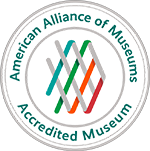Why Ask Questions / VTS
WHY ASK STUDENTS QUESTIONS ABOUT ART?
Artists observe the world around them and respond by creating art. At the Yellowstone Art Museum, all our educational programming is based on Visual Thinking Strategies. We have seen this method, based in three questions, engage students of all ages.
HOW VISUAL THINKING STRATEGIES (VTS) WORK
VTS is very simple: You, the teacher, act as facilitator and ask students a set of questions while looking at images. After each student’s response, you paraphrase what the student said. This lets students know that you understand them and helps ensure that everyone in the group has heard the comments. Repeating what students say also helps them realize that their contributions to discussions are valid. Consequently, students will begin to feel comfortable and confident about speaking up. As you listen to students, point to the parts of the picture they mention. This demonstrates that you hear them. It also keeps the class’ attention focused on the image.
Asking the questions AND acknowledging each answer by pointing and paraphrasing are the most important things you do in this method.
As students become familiar with looking at and talking about art, they will respond to the same questions with increasingly sophisticated observations and interpretations. VTS emphasizes a thinking process based on the viewers’ knowledge and interests. The strategy does not try to provide any more information than what the viewer observes. The VTS focus on looking and describing constitutes the first step toward building an understanding and appreciation of the visual arts.
Questions to Ask during VTS:
1. What’s going on in this picture?
2. What do you see that makes you say that?
3. What more can you find?
What Is VTS?
Source: http://www.castellaniartmuseum.org
VTS questions and additional guiding questions are included in every lesson.
PDF: Basic Components of Visual Thinking Strategies
PDF: Visual Thinking strategies Overview and How To
Visual Thinking Strategies














